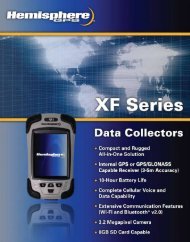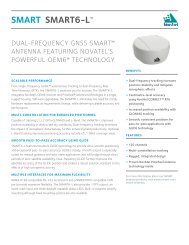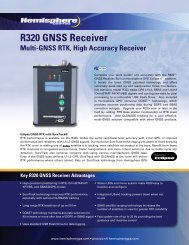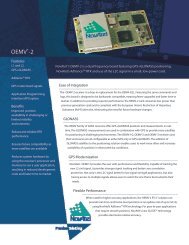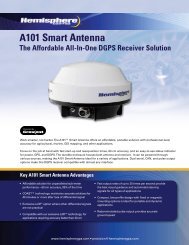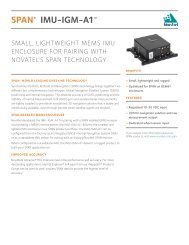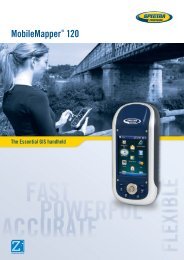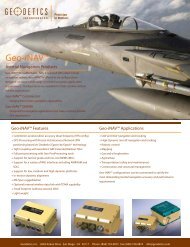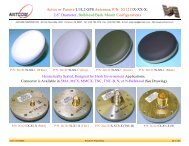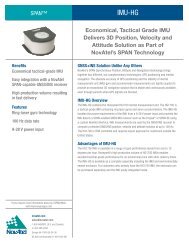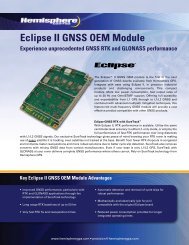miniEclipse GNSS Receiver Board - Canal Geomatics
miniEclipse GNSS Receiver Board - Canal Geomatics
miniEclipse GNSS Receiver Board - Canal Geomatics
You also want an ePaper? Increase the reach of your titles
YUMPU automatically turns print PDFs into web optimized ePapers that Google loves.
<strong>miniEclipse</strong> <strong>GNSS</strong> <strong>Receiver</strong> <strong>Board</strong><br />
The world’s smallest dual-frequency <strong>GNSS</strong> receiver<br />
Built as the world’s smallest dual-frequency <strong>GNSS</strong> receiver<br />
board, <strong>miniEclipse</strong> by Hemisphere GPS offers integrators<br />
unprecedented performance for applications where size and<br />
space are critical. Measuring 41 millimeters by 71 millimeters in<br />
size, the low power consumption and simple on-board firmware<br />
of <strong>miniEclipse</strong> make it an ideal solution, offering scalability and<br />
expandability from L1 GPS with SBAS to L1/L2 GPS with RTK.<br />
<strong>miniEclipse</strong> takes Hemisphere GPS’ latest Eclipse II technology<br />
and shrinks it into a tiny package. <strong>miniEclipse</strong> receivers are<br />
offered in two common industry form factors: P200 and P201.<br />
P200 is a drop-in replacement for Hemisphere GPS’ Crescent ®<br />
receiver, while P201 has a mechanical design compatible<br />
with SSII/OEMV ® -1 or OEMV ® -1DF receivers of NovAtel, Inc.<br />
The reliable positioning performance of <strong>miniEclipse</strong> is further<br />
enhanced through Eclipse RTK and COAST DGPS technology.<br />
Eclipse RTK with SureTrack<br />
With <strong>miniEclipse</strong>, RTK performance is scalable. Utilize the same centimeter-level accuracy in either L1-only mode,<br />
or employ the full performance of fast RTK performance over long distances with L1/L2 GPS signals. Our exclusive<br />
SureTrack technology gives peace of mind knowing the RTK rover is making use of every satellite it is tracking, even<br />
satellites not tracked at the base. Benefit from fewer RTK dropouts in congested environments, faster reacquisitions<br />
and more robust solutions due to better cycle slip detection. Rely on SureTrack technology from Hemisphere GPS.<br />
DGPS and SBAS with COAST<br />
Patented COAST software enables select Hemisphere GPS receivers to utilize previous DGPS correction data during times<br />
of interference, signal blockage and weak signal. The receiver will coast and continue to maintain sub-meter positioning<br />
for up to 40 minutes without any DGPS signal.<br />
Key <strong>miniEclipse</strong> <strong>GNSS</strong> <strong>Receiver</strong> <strong>Board</strong> Advantages<br />
• Improved GPS performance with Long Range RTK<br />
applications up to 50 km<br />
• RTK fix times are improved providing fast solutions<br />
• Compatible with other RTK sources including<br />
Hemisphere GPS’ ROX Format, RTCM v3, CMR,<br />
CMR+<br />
• Reliable DGPS accuracy for up to 40 minutes using<br />
Hemisphere GPS’ COAST technology<br />
• Extremely affordable DGPS solution with update<br />
rates of up to 20 Hz<br />
www.hemispheregps.com • precision@hemispheregps.com
<strong>miniEclipse</strong> <strong>GNSS</strong> <strong>Receiver</strong> <strong>Board</strong><br />
GPS Sensor Specifications<br />
<strong>Receiver</strong> Type:<br />
L1 & L2 RTK with carrier phase<br />
Channels:<br />
12 L1CA GPS<br />
12 L1P GPS<br />
12 L2P GPS (with subscription code)<br />
12 L2C GPS (with subscription code)<br />
3 SBAS or 3 additional L1CA GPS<br />
SBAS Tracking:<br />
3-channel, parallel tracking<br />
Update Rate:<br />
1 Hz standard, 10 Hz and 20 Hz available<br />
Timing (1PPS) Accuracy: 20 ns<br />
Cold Start Time: < 60 s typical (no almanac or RTC)<br />
Warm Start Time: < 30 s typical (almanac and RTC)<br />
Hot Start Time:<br />
< 10 s typical (almanac, RTC and position)<br />
Maximum Speed: 1,850 kph (999 kts)<br />
Maximum Altitude: 18,288 m (60,000 ft)<br />
Differential Options: SBAS, Autonomous, External RTCM v2.3,<br />
RTK v3<br />
Horizontal Accuracy<br />
RMS (67%) 2DRMS (95%)<br />
RTK: 2,3<br />
10 mm + 1 ppm 20 mm + 2 ppm<br />
SBAS (WAAS): 2 0.3 m 0.6 m<br />
Autonomous, no SA: 2<br />
1.2 m 2.5 m<br />
Communications<br />
Serial Ports:<br />
4 full-duplex 3.3 V CMOS (3 main serial ports,<br />
1 differential-only port)<br />
Baud Rates: 4800 - 115200<br />
Correction I/O Protocol: Hemisphere GPS’ ROX, RTCM v2.3 (DGPS),<br />
RTCM v3 (RTK), CMR, CMR+ 1<br />
Data I/O Protocol: NMEA 0183, Hemisphere GPS binary<br />
Timing Output:<br />
1 PPS (CMOS, active low, falling edge sync,<br />
10 kΩ, 10 pF load)<br />
Event Marker Input: CMOS, active low, falling edge sync, 10 kΩ,<br />
10 pF load<br />
USB:<br />
1 USB device<br />
Current Consumption:<br />
Antenna Voltage Input:<br />
Antenna Short Circuit<br />
Protection:<br />
Antenna Gain Input Range:<br />
Antenna Input Impedance:<br />
Environmental<br />
Operating Temperature:<br />
Storage Temperature:<br />
Humidity:<br />
Shock and Vibration: 4<br />
EMC: 4<br />
410 mA nominal (L1/L2 RTK)<br />
380 mA nominal (L1 SBAS)<br />
15 VDC maximum<br />
Yes<br />
10 to 40 dB<br />
50 Ω<br />
-40°C to +85°C (-40°F to +185°F)<br />
-40°C to +85°C (-40°F to +185°F)<br />
95% non-condensing (when installed in an<br />
enclosure)<br />
Vibration: EP455 Section 5.15.1 Random<br />
Mechanical Shock: EP455 Section<br />
5.14.1 Operational (when mounted in an<br />
enclosure with screw mounting holes utilized)<br />
CE (IEC 60945 Emissions and Immunity)<br />
FCC Part 15, Subpart B, CISPR22<br />
Mechanical<br />
Dimensions<br />
P200: 7.1 L x 4.1 W x 1.3 H (cm)<br />
2.8 L x 1.6 W x 0.53 H (in)<br />
P201: 7.2 L x 4.1 W x 1.3 H (cm)<br />
2.85 L x 1.6 W x 0.53 H (in)<br />
Weight:<br />
< 20 g (< 0.7 oz)<br />
Status Indication (LED): Power, GPS lock, Differential lock,<br />
DGPS position<br />
Power/Data Connector<br />
P200: 34-pin ( 17x2) male header, 0.05”<br />
(1.27 mm) pitch<br />
P201: 20-pin (10 x 2) male header, 0.08”<br />
(2 mm) pitch<br />
Antenna Connector: MCX,<br />
female, straight<br />
Power<br />
Input Voltage: 3.3 VDC +/- 5%<br />
Power Consumption: < 1.35 W nominal (L1/L2 RTK)<br />
< 1.25 W nominal (L1 SBAS)<br />
Back View<br />
Authorized Distributor:<br />
1 Receive only, does not transmit this format.<br />
2 Depends on multipath environment, number of satellites in view, satellite geometry<br />
and ionospheric activity.<br />
3 Depends also on baseline length.<br />
4 When integrated in conjunction with the recommended shielding and protection as<br />
outlined in the Integrator’s Guide.<br />
Note: The Eclipse receiver technology is not designed or modified to use the GPS Y-Code<br />
HEMISPHERE GPS<br />
4110 - 9th Street S.E.<br />
Calgary, AB T2G 3C4<br />
Canada<br />
Phone: 403.259.3311<br />
Fax: 403.259.8866<br />
precision@hemispheregps.com<br />
www.hemispheregps.com<br />
Copyright 2011, Hemisphere GPS. All rights reserved. Specifications subject to change without notice.<br />
OEMV is a registered trademark of NovAtel, Inc., which is not related to Hemisphere GPS. Hemisphere GPS, Hemisphere GPS logo,<br />
Eclipse, Eclipse logo, <strong>miniEclipse</strong>, P200, P201, COAST and SureTrack are trademarks of Hemisphere GPS. OmniSTAR is a registered<br />
trademark of OmniSTAR, Inc. Rev. 9/11.




